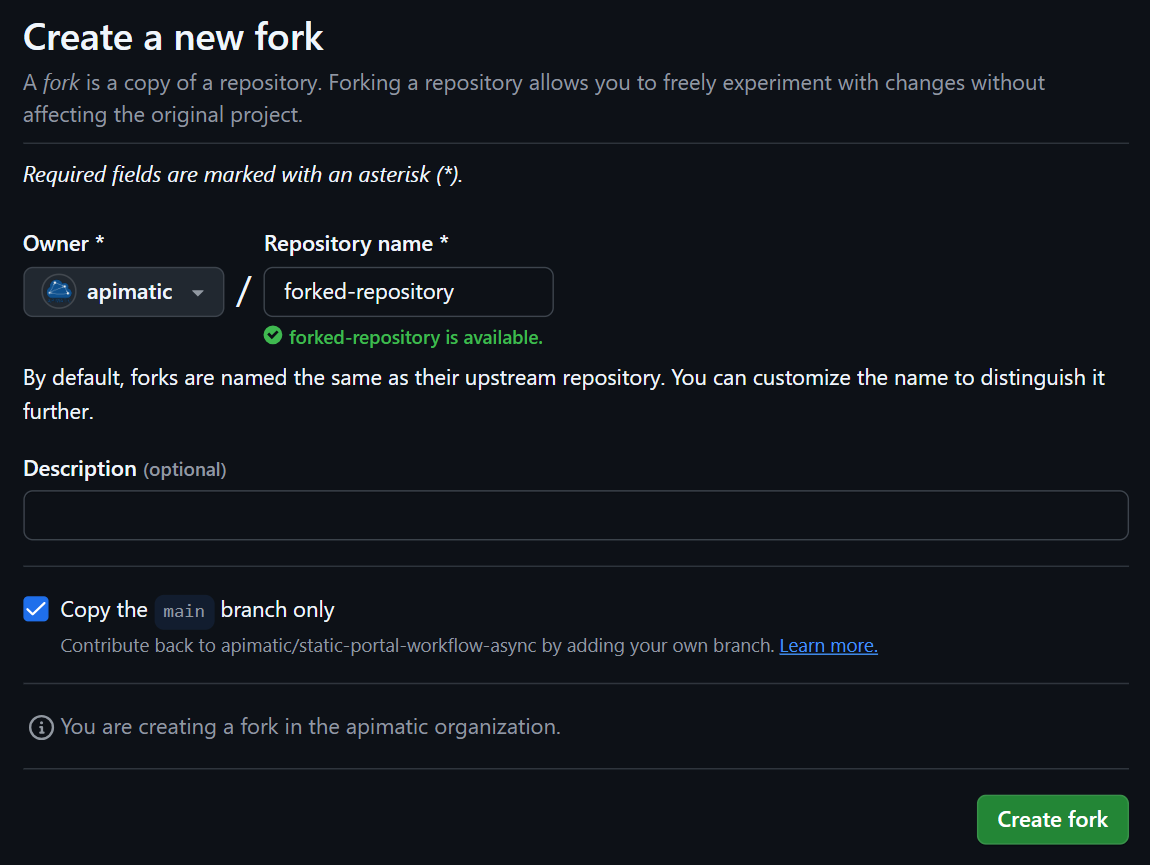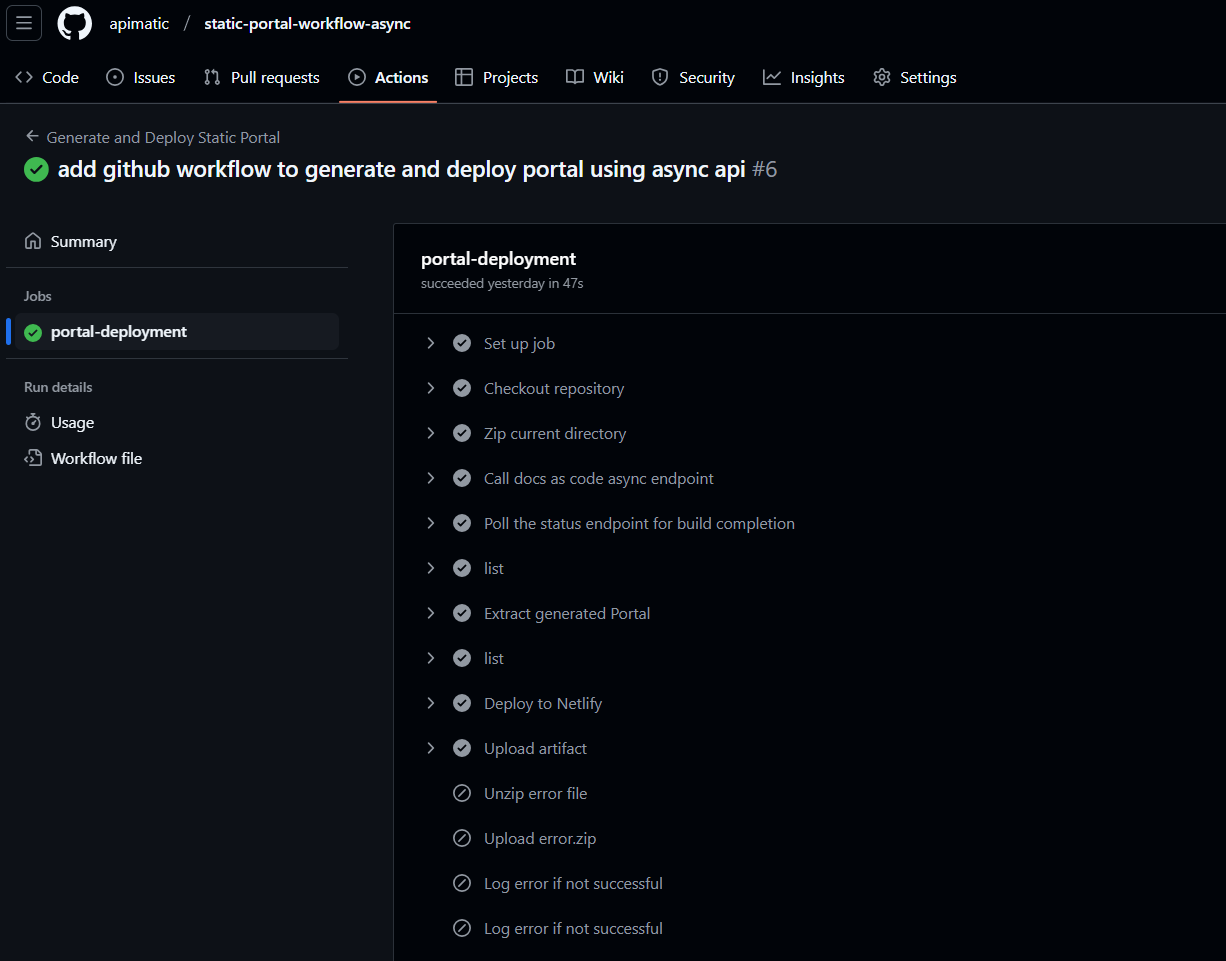Automate using the Async API
You can automate the docs-as-code process using GitHub Actions, ensuring that any changes to your documentation are instantly deployed.
Workflow Overview
Whenever a change is pushed to the GitHub repository:
The repository contents are zipped and sent to the Portal Generation Async Endpoint.
The returned status endpoint URL is polled periodically.
Once generation is complete, the portal artifacts are downloaded, extracted, and deployed to a hosting service.
Take a look at the GitHub repository for a sample GitHub workflow.
Step 1: Fork the Sample Repository
Click Fork on the top-right corner of the sample GitHub repository.
Choose an Owner, provide a Repository name, and optionally add a Description.
Click Create Fork.

The forked repository contains a workflow file, DeployStaticPortalAsync.yml, located in .github/workflows/. This file defines the steps to build and deploy the API Portal.
Step 2: Configure the Workflow
The workflow file, DeployStaticPortalAsync.yml, executes the following steps:
Check out the repository.
Zip the repository contents.
Call APIMatic’s Portal Generation Async API.
Extract the status endpoint URL from the API response.
Poll the status endpoint every 10 seconds.
Once completed, download and unzip the portal artifacts.
Deploy the portal to Netlify.
DeployStaticPortalAsync.yml file
name: Generate and Deploy Static Portal
on:
push:
branches:
- main
jobs:
portal-deployment:
timeout-minutes: 5
runs-on: ubuntu-latest
steps:
- name: Checkout repository
uses: actions/checkout@v4
- name: Zip current directory
run: |
zip -r build-input.zip . -x .git/\* -x .github/\* -x build-input.zip
- name: Call docs as code async endpoint
id: upload
run: |
RESPONSE=`curl --silent --write-out '%{http_code}\t%{content_type}' --output response1.json --location 'https://api.apimatic.io/portal/v2' \
--header 'Authorization:X-Auth-Key ${{ secrets.API_KEY }}' --form 'file=@build-input.zip'`
HTTP_CODE=$(echo $RESPONSE | cut -d " " -f 1);
CONTENT_TYPE=$(echo $RESPONSE | cut -d " " -f 2);
echo "HTTP_CODE=$HTTP_CODE" >> $GITHUB_OUTPUT;
echo "CONTENT_TYPE=$CONTENT_TYPE" >> $GITHUB_OUTPUT;
echo "Full response:"
cat response1.json
if [[ "$HTTP_CODE" == "202" ]]; then
status_url=$(jq -r '.links.status' response1.json)
echo "status_url=$status_url" >> $GITHUB_OUTPUT
else
echo "Failed to upload build input. HTTP_CODE=$HTTP_CODE"
exit 1
fi
- name: Poll the status endpoint for build completion
id: generate-portal
run: |
status_url=${{ steps.upload.outputs.status_url }}
while true; do
echo "Polling status URL: $status_url"
response=$(curl --silent --write-out '%{http_code}\t%{content_type}' --output response.json --header 'Authorization: X-Auth-Key ${{ secrets.API_KEY }}' "$status_url")
echo "Pre redirect response: $response"
HTTP_CODE=$(echo "$response" | cut -f1 -d $'\t')
CONTENT_TYPE=$(echo "$response" | cut -f2 -d $'\t')
if [[ "$HTTP_CODE" == "302" ]]; then
echo "Redirect received. Following the redirect to download the file..."
RESPONSE=$(curl -L --silent --write-out '%{http_code}\t%{content_type}' --header 'Authorization: X-Auth-Key ${{ secrets.API_KEY }}' "$status_url" -OJ)
echo "Post redirect response: $RESPONSE"
POLL_HTTP_CODE=$(echo "$RESPONSE" | cut -f1 -d $'\t')
POLL_CONTENT_TYPE=$(echo "$RESPONSE" | cut -f2 -d $'\t')
echo "HTTP_CODE=$POLL_HTTP_CODE" >> $GITHUB_OUTPUT
echo "CONTENT_TYPE=$POLL_CONTENT_TYPE" >> $GITHUB_OUTPUT
break
fi
if [[ "$HTTP_CODE" == "200" ]]; then
status=$(jq -r '.status' response.json)
echo "Status: $status"
if [[ "$status" == "InProgress" ]]; then
echo "Build still in progress. Retrying in 10 seconds..."
sleep 10
else
echo "Unexpected status: $status"
exit 1
fi
else
echo "Unexpected response: $response. Exiting."
exit 1
fi
done
- name: list
run: ls
- name: Extract generated Portal
if: ${{steps.generate-portal.outputs.HTTP_CODE == '200'}}
run: unzip -qq portal.zip -d static-portal
- name: list
run: ls
- name: Deploy to Netlify
if: ${{steps.generate-portal.outputs.HTTP_CODE == '200'}}
uses: nwtgck/actions-netlify@v2.0
with:
publish-dir: './static-portal'
production-branch: main
github-token: ${{ secrets.GITHUB_TOKEN }}
deploy-message: "Deploy from GitHub Actions"
enable-pull-request-comment: false
enable-commit-comment: true
overwrites-pull-request-comment: true
env:
NETLIFY_AUTH_TOKEN: ${{ secrets.NETLIFY_AUTH_TOKEN }}
NETLIFY_SITE_ID: ${{ secrets.NETLIFY_SITE_ID }}
timeout-minutes: 2
- name: Upload artifact
if: ${{steps.generate-portal.outputs.HTTP_CODE == '200' }}
uses: actions/upload-artifact@v4
with:
name: static-portal
path: static-portal
- name: Unzip error file
if: ${{steps.generate-portal.outputs.HTTP_CODE == '422' && steps.generate-portal.outputs.CONTENT_TYPE == 'application/zip'}}
run: unzip -qq error.zip -d error
- name: Upload error.zip
if: ${{steps.generate-portal.outputs.HTTP_CODE == '422' && steps.generate-portal.outputs.CONTENT_TYPE == 'application/zip'}}
uses: actions/upload-artifact@v4
with:
name: error
path: error
- name: Log error if not successful
if: ${{steps.generate-portal.outputs.HTTP_CODE != '200' && steps.generate-portal.outputs.CONTENT_TYPE != 'application/zip'}}
run: |
echo "The Portal Generation request failed with response code ${{steps.generate-portal.outputs.HTTP_CODE}} and message $(cat portal)"; \
exit 1
- name: Log error if not successful
if: ${{steps.generate-portal.outputs.HTTP_CODE != '200' && steps.generate-portal.outputs.CONTENT_TYPE == 'application/zip'}}
run: |
echo "The Portal Generation request failed with response code ${{steps.generate-portal.outputs.HTTP_CODE}}; \
exit
You can deploy to other platforms such as Cloudflare Pages or Azure Static Web Apps.
Step 3: Set Up Repository Secrets
Since GitHub doesn't copy secrets when forking repositories, you need to reconfigure them manually:
Go to your forked GitHub repository.
Navigate to Settings > Secrets > Actions.
Click New repository secret and add the required credentials.

Step 4: Trigger the Workflow
The workflow runs automatically whenever a commit is pushed to the main branch.
You can also manually trigger the workflow from the GitHub Actions tab.
Once the workflow completes, the updated portal will be available on the deployed server.
